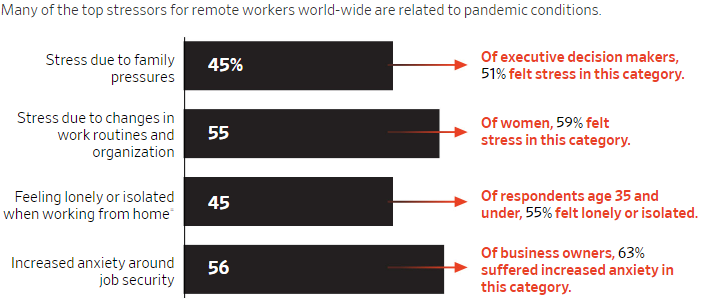Stress - Kids - Lonely - Isolated - Anxiety - Job
Security?
So, You Think You’ve Tried Remote Work? You Probably Haven’t.
If it was during the pandemic, you don’t really
know what it’s like. You might want to try again.
 As
offices reopen and companies move toward a hybrid workplace, about
half of today’s remote workers (and most of their bosses) are eager to
return to the office, at least most of the time. I’ve done the remote thing,
they say, and it doesn’t work for me.
As
offices reopen and companies move toward a hybrid workplace, about
half of today’s remote workers (and most of their bosses) are eager to
return to the office, at least most of the time. I’ve done the remote thing,
they say, and it doesn’t work for me.
To those workers I say: You only think you know what it’s like to work remotely.
But remote work in normal times (remember those?) is completely different than
working at home under pandemic conditions.
How different will it be once the pandemic is behind us? As somebody who has
worked remotely for 18 years—and found the past 18 months more than
challenging—let me count the many ways.
The pandemic was a uniquely stressful time for individuals and organizations to
try remote work. For one thing, it meant that the transition to remote work
happened overnight, without any opportunity to prepare.
At the same time, the pandemic-induced downturn meant that employees had to
adjust to working from home while worrying about whether they would soon be
unemployed. Not to mention coping with personal or family health crises—or
worrying about the possibility of getting sick and dying.
It’s fair to say that the anxiety of Covid has tainted many people’s impressions
of working remotely.
You love your kids, but…
Another plus of living outside a pandemic is this delightful child-care program
known as school. So many people experienced remote work for the first time while
also having their first experience of home schooling, or at least having their
children to care for all day. It is much easier to work remotely when your kids
leave the house during your workday, or if they are going to be at home, having
the ability to arrange for off-site or on-site child care.
Common Complaints

People
need people
Remote work can be isolating—but outside of a pandemic, it doesn’t have to be.
When I first worked remotely, I fell into the trap of spending day after
solitary day alone in my apartment, grinding out my work. Many remote workers
use co-working spaces and coffee shops as alternatives to working from home all
the time, or make co-working dates with other colleagues so that they aren’t so
isolated—all things that were largely off-limits during Covid.
And don’t forget that business travel will resume, even if it isn’t at the same
level as before the pandemic. That will give people an infusion of social
interaction and a welcome break from the monotony of home, and allow them to
appreciate the quiet and solitude they get during days in their home office.
People also need structure
&uuid=(email))
Spending part of your workweek at a coffee shop or co-working space is just one
way to bring a little more structure to your remote workday once you’re no
longer stuck at home all the time. You can start or end your workday with a trip
to the gym, plan a daily lunch meeting with a colleague you find energizing and
inspiring, or meet up with a friend at the end of the workday—which doesn’t have
to wait until 5.
A
balanced life
Remember, unlike during the pandemic, working remotely isn’t an all-or-nothing
proposition. If you’re lucky enough to have a choice, and you decide full-time
remote work isn’t for you, you can spend two or three days a week at the office
to get the benefit of collegial interaction and face-to-face collaboration,
while enjoying the concentration and flexibility that come from spending the
rest of your time at home or parked at your favorite coffee shop.
Fewer meetings
Many longtime remote workers I know talk about how much their meeting time
increased over the course of the pandemic—a phenomenon I experienced myself. In
part, that was because people stuck at home were starving for connection. But
also, it’s just so easy to add somebody to a video call.
The best of both worlds
Remember, unlike during the pandemic, working remotely isn’t an all-or-nothing
proposition. If you’re lucky enough to have a choice, and you decide full-time
remote work isn’t for you, you can spend two or three days a week at the office
to get the benefit of collegial interaction and face-to-face collaboration,
while enjoying the concentration and flexibility that come from spending the
rest of your time at home or parked at your favorite coffee shop.
But for those who look at the past year and a half and say they aren’t cut out
for remote work, my advice is not to throw in the towel just yet. Maybe it
wasn’t remote work you hated. Maybe it was the pandemic.
wsj.com